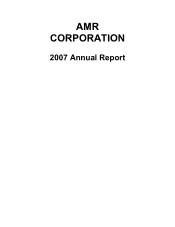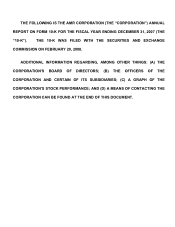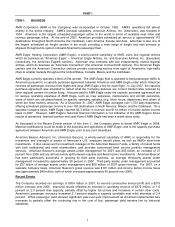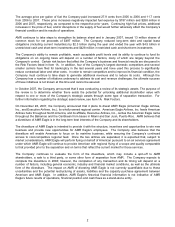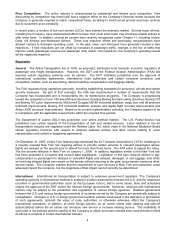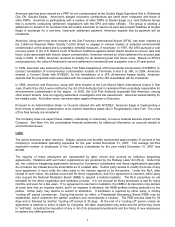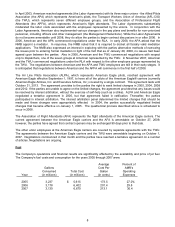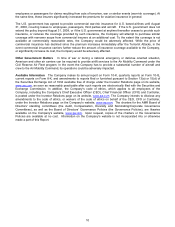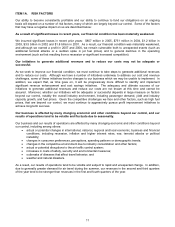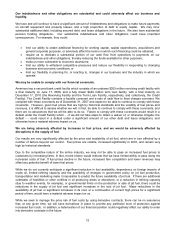American Airlines 2007 Annual Report Download - page 5
Download and view the complete annual report
Please find page 5 of the 2007 American Airlines annual report below. You can navigate through the pages in the report by either clicking on the pages listed below, or by using the keyword search tool below to find specific information within the annual report.2
The average price per gallon of fuel the Company paid increased 27.9 cents from 2005 to 2006 and 11.7 cents
from 2006 to 2007. These price increases negatively impacted fuel expense by $787 million and $268 million in
2006 and 2007, respectively, as compared to the respective prior years. Continuing high fuel prices, additional
increases in the price of fuel, and/or disruptions in the supply of fuel would further adversely affect the Company’s
financial condition and its results of operations.
AMR continues to take steps to strengthen its balance sheet and in January 2007, issued 13 million shares of
common stock for net proceeds of $497 million. The Company reduced long-term debt and capital lease
obligations (including current maturities) by $2.3 billion during the year and ended the year with $4.5 billion in
unrestricted cash and short-term investments and $428 million in restricted cash and short-term investments.
The Company’s ability to remain profitable, reach acceptable profit levels and its ability to continue to fund its
obligations on an ongoing basis will depend on a number of factors, many of which are largely beyond the
Company’s control. Certain risk factors that affect the Company’s business and financial results are discussed in
the Risk Factors listed in Item 1A. In addition, four of the Company’s largest domestic competitors and several
smaller carriers have filed for bankruptcy in the last several years and have used this process to significantly
reduce contractual labor and other costs. In order to remain competitive and to improve its financial condition, the
Company must continue to take steps to generate additional revenues and to reduce its costs. Although the
Company has a number of initiatives underway to address its cost and revenue challenges, the ultimate success
of these initiatives is not known at this time and cannot be assured.
In October 2007, the Company announced that it was conducting a review of its strategic assets. The purpose of
the review is to determine whether there exists the potential for unlocking additional stockholder value with
respect to one or more of the Company’s strategic assets through some type of separation transaction. For
further information regarding the strategic asset review, see Item 1A. Risk Factors.
On November 28, 2007, the Company announced that it plans to divest AMR Eagle (American Eagle Airlines,
Inc., and Executive Airlines, Inc.), its wholly-owned regional carrier. American Eagle Airlines, Inc. feeds American
Airlines hubs throughout North America, and its affiliate, Executive Airlines, Inc., carries the American Eagle name
throughout the Bahamas and the Caribbean from bases in Miami and San Juan, Puerto Rico. AMR believes that
a divestiture of AMR Eagle is in the long-term best interests of the Company and its shareholders.
The divestiture of AMR Eagle is intended to provide it with the structure, incentives and opportunities to win new
business and provide new opportunities for AMR Eagle’s employees. The Company also believes that the
divestiture will enable American to focus on its mainline business, while ensuring the Company’s continued
access to cost-competitive regional feed. Once the two airlines are separated, it is expected that, subject to
market considerations, AMR Eagle will perform flying on behalf of American pursuant to an air services agreement
under which AMR Eagle will continue to provide American with regional flying of a scope and quality comparable
to that provided prior to the separation and on terms that reflect the current market for those services.
The Company continues to evaluate the form of the divestiture, which may include a spin-off to AMR
shareholders, a sale to a third party, or some other form of separation from AMR. The Company expects to
complete the divestiture in 2008; however, the completion of any transaction and its timing will depend on a
number of factors, including general economic, industry and financial market conditions, as well as the ultimate
form of the divestiture. The impact on AMR of divesting AMR Eagle is not currently quantifiable due to these
uncertainties and the potential restructuring of assets, liabilities and the capacity purchase agreement between
American and AMR Eagle. In addition, AMR Eagle’s historical financial information is not indicative of AMR
Eagle’s future results of operations, financial position and cash flows as a stand-alone entity.

